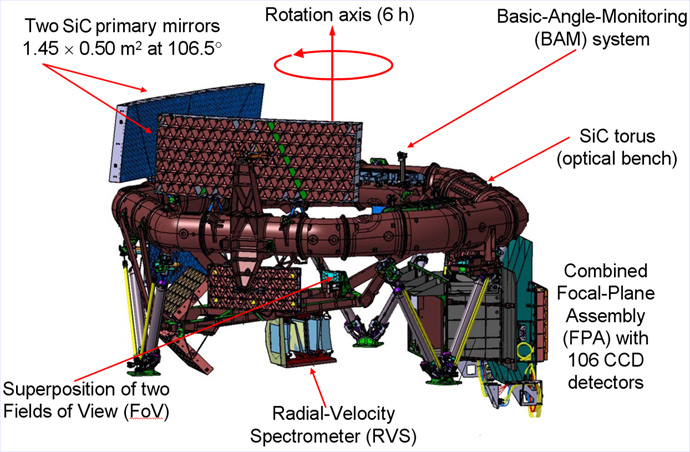Gaia's payload consits of (see the payload diagram):
- two telescopes, sharing a single focal plane,
- the astrometric instrument, used for measuring star positions, from which proper motions and parallaxes are derived,
- the photometric instrument, which is used to measure red and blue low resolution dispersion spectra produced by the Blue and Red Photometers (with respective wavelength ranges 320-660 and 650-1000 nm) for each object,
- Radial Velocity Spectrometer (RVS), which uses a narrow section of a high resolution spectrum (wavelength range 847-874 nm) for radial velocity measurements for all objects brighter than around 17th magnitude. RVS measurements will also allow astronomers to determine atmospheric parameters (such as the temperature, density and chemical composition) of a smaller number of stars.
All of the above share the same focal plane, an array of 106 charge-coupled devices (CCDs), which is just over 104 cm long and just over 42 cm wide, and contains nearly 1 billion pixels. (See the focal plane diagram, "Focal plane and observation sequence page".) The CCDs were made in the UK by e2v. You can find out more about Gaia's CCDs and some of the challenges, which they presented to Gaia's scientists and engineers on the following pages: How CCDs work, The Gaia CCD challenge, Edinburgh University contribution to ESA Gaia: calibrating instrumental artefacts and The Gaia DPAC Radiation Task Force.
Gaia's instruments are mounted on a 3.5 m diameter hexagonal optical bench, made entirely of silicon carbide, a material with particularly good thermal and mechanical properties. Also all mirrors are also made of the same material. Focal length of each telescope is 35 m. Their viewing directions are separated by a basic angle of 106.5°, and each viewing field is 1.7° by 0.6° in size.

Gaia's payload. The diagram shows the mirrors of the two telescopes and the instruments mounted on optical bench. The telescopes scan the sky as the satellite rotates around its rotation axis, completing a full revolution every 6 hours. View larger image (250 KB). (Image courtesy of EADS Astrium.)
A detailed description of Gaia's payload can be found in Payload module section of Gaia pages on ESA's website.
Page last updated: 18 November 2021
